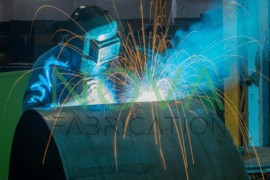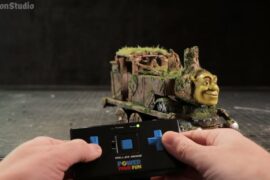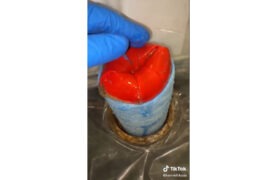Recently, we covered how commercial vinyl records are made by a processing plant. However, what if you could make your own records from the comfort of home?
Eager to go vintage vinyl and migrate more music from digital to analog, Seth Nicholas Johnson of Haunted Birthday Records shows an easy way to make homemade records:
1. Cut Some Polycarbonate Plastic

While most records you find in a store are made from vinyl, the materials used to make them aren’t as easy to acquire. Instead, Seth recommends using a sheet of polycarbonate plastic, which is easier to acquire and has just as much malleability and potential sound quality as vinyl does.

You can cut your record into whatever shape you like (a circle is usually the norm), but make sure you drill a hole in the middle using either a drill press or a hand drill. In Seth’s case, he cuts his record into a square shape and drills a hole using his drill press.
2. Acquire and Master Your Desired Audio

The next thing you need is some audio to store into the polycarbonate. Once you have the audio files, make sure to master said audio so it stays as true as possible to the original material. (He’s using the freely available Audacity software in this example.) This is where some trial and error comes in but his main recommendation is to apply an Inverse RIAA Curve to make it less noisy.
3. Calibrate Your Recording Equipment

This is where Seth’s method for making homemade records gets a bit dubious and, really, can differ widely depending on your budget and available equipment. Not everyone has a mixing board, equalizer, or record lathe in their home, yet these are some of the most important things needed to record audio onto a piece of polycarbonate.

Regardless, he highly suggests checking each piece of equipment to make sure it is configured to the type of audio you wish to record. This ranges from something as simple as adjusting volume to completely recalibrating your equalizer.
4. Emboss And Record Your… Record

To record audio onto your polycarbonate sheet, you have to first make it temporarily malleable. Apply some turtle wax or lighter fluid onto the polycarbonate and once it’s fully coated, set it on your record lathe and drop the needle to begin the recording process.

5. Refine and Adjust Your Recording Process

The first record you make will unlikely be the one you keep. There will be problems with your first, second, and maybe even tenth attempt at making a record, be it equalizing issues or a dull recording needle.
When this happens, recalibrate your equipment and start again until you’re happy with the final product. It will take some time, but having your own record to listen to is definitely worth it.
6. Label and Box Your Final Record

After much remastering and rerecording, you will hopefully have a record you are happy with. All that’s left to do now is label said record, give it a sleeve, and add some décor to make it all your own.
If you want to skip this whole process and just have embossed records sent to you directly, Haunted Birthday Records makes handmade, lathe-embossed records for you to enjoy. Check them out for some great music too.







